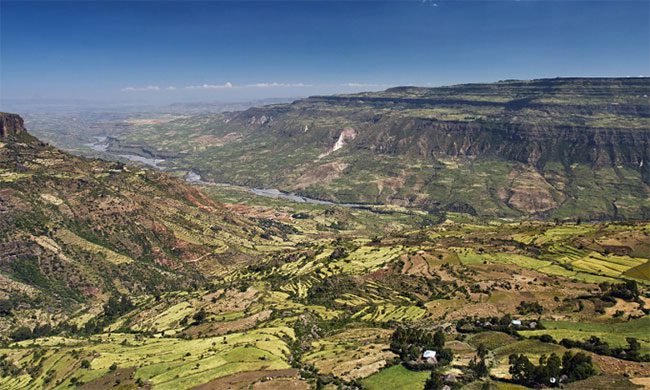A massive rift known as the East African Rift is slowly splitting apart Africa, the world’s second-largest continent.
Is it possible for Africa to be completely divided in the future, and if so, when might this occur? First, let’s consider tectonic plates – the outer plates of the Earth’s surface that can collide with one another to form mountains, or pull apart to create vast basins.

Fields in the Great Rift Valley of Ethiopia, part of the East African Rift. (Photo: LuCaAr)
The East African Rift is a network of valleys that stretches about 3,500 km from the Red Sea to Mozambique, according to the Geological Society of London (GSL). Along this massive crack, the Somalia tectonic plate is being pulled eastward, separating from the larger and older African plate – Nubia, as reported by NASA’s Earth Observatory. The Nubian plate is also referred to as the African plate.
The two plates, Somalia and Nubia, are also separating from the Arab plate to the north. These tectonic plates intersect at Afar, Ethiopia, forming a Y-shaped rift system.
The East African Rift began to form between the Arab plate and the Horn of Africa about 35 million years ago, Cynthia Ebinger, chair of the geology department at Tulane University, shared with Live Science on June 17. This rift has been expanding southward over time, reaching northern Kenya 25 million years ago.
The rift consists of two sets of parallel cracks in the Earth’s crust. The eastern crack runs through Ethiopia and Kenya, while the western crack arches from Uganda to Malawi. The eastern branch is arid, while the western branch lies at the edge of the Congo rainforest, according to NASA’s Earth Observatory.
Ebinger noted that the existence of the eastern and western cracks, along with the detection of earthquake and volcanic activity offshore, indicates that Africa is slowly pulling apart along several rift lines at a rate of about 6.35 mm per year.
The East African Rift is likely formed due to upwelling heat from the asthenosphere – the hotter, weaker part of the Earth’s mantle – between Kenya and Ethiopia. This heat causes the overlying crust to swell and rise, leading to the continental rock becoming brittle and fracturing.
There are multiple scenarios regarding what will happen when Africa splits in two. According to one scenario, most of the Somalia tectonic plate will separate from the rest of the African continent, and a sea will emerge between them. The new landmass would include Somalia, Eritrea, Djibouti, and the eastern regions of Ethiopia, Kenya, Tanzania, and Mozambique. “Another scenario is that only the eastern parts of Tanzania and Mozambique will separate,” Ebinger stated.
Ebinger remarked that if the African continent were to split, the rift in Ethiopia and Kenya could separate to create the Somalia plate within the next 1 to 5 million years.
However, Africa may not split at all. According to Ebinger, the geological forces driving the rifting may be too slow to separate the Somalia and Nubia plates. A prominent example of a failed rift is the Mid-Continent Rift, which stretches about 3,000 km through the Upper Midwest of North America. According to GSL, the eastern branch of the East African Rift is a failed rift. However, the western branch remains active.


















































